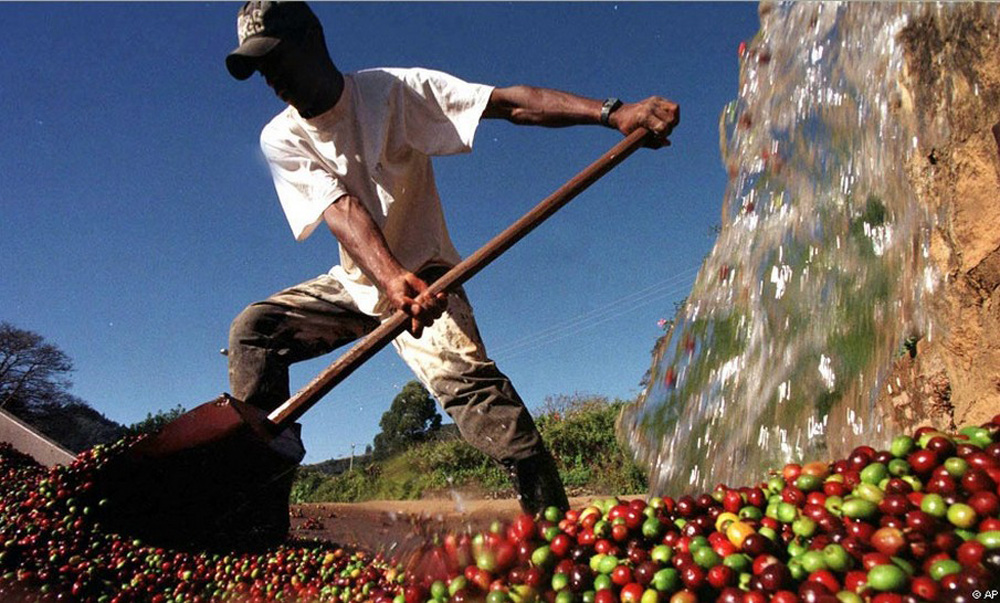The global price of coffee beans affected by drought in Brazil is likely to rise by another 50% this year.

Photo: Brazil is the world's largest coffee producer, with 17 of the 21 states producing coffee. The picture shows Brazilian coffee workers collecting coffee beans.
Dagong Finance and Economics, February 16 (Reporter Zheng Yunyang) since it was introduced into Europe through Italy, the smell of coffee has spread to every corner of the world. Production in Brazil, the world's largest coffee producer, has declined in recent years, and coffee prices rose 50% year-on-year in 2014. Traders predict that if supply and demand continue to be out of balance, coffee bean prices may rise by 40% to 50% this year, and coffee fans around the world may have to continue to endure expensive coffee.
Although commodity prices are weak, the price of coffee beans remains stable. Coffee was the best-performing commodity in 2014, outperforming crude oil, natural gas, copper and soybeans. The price of Arabica beans (Arabrica), commonly known as Arabica coffee, rose 50 per cent last year and was still up 5-8 per cent at the start of the year, and commodity traders are bullish on the prospect of coffee. In fact, in the commodity market, crude oil is the largest trading volume, followed by coffee beans.
The price has risen to more than two dollars per pound.
After the sharp rise in coffee prices in 2014, prices have remained stable so far this year because of supply and demand. Brazil, the world's largest coffee producer, has experienced its worst drought in more than a decade, resulting in a sharp drop in global coffee supplies.
Brazil supplies one-third of the world's coffee demand, but Brazil's coffee harvest in 2014 was the worst in three years. Coffee prices rose further, rising above $2 a pound, and large coffee chains such as Starbucks quickly followed suit to raise the price of coffee drinks.
The two major varieties of coffee, the most popular in the market is Arabica coffee beans, which are produced in Latin American countries, including Brazil and Colombia, and coffee futures on the New York ICE Exchange in the United States are traded on Arabica beans from 19 countries.
Robusta is the second largest variety of coffee in the world, accounting for about 20% of the world coffee production. It has a strong sour taste and is mainly grown in some tropical countries such as Indonesia, mostly for instant coffee.
Colombia is the third largest coffee producer in the world and the second largest Arabica bean producer in the world. Although it has accelerated production to meet global demand for coffee, Colombia's coffee production is only about one-fourth of that of Brazil. Even if production increases, it can only temporarily ease the shortage of coffee supply.
Coffee farmers in coffee-producing countries make money only if coffee beans sell for at least one dollar per pound. If the price of coffee beans falls below one dollar, the income of coffee-producing countries may be affected, and production needs to be adjusted to support coffee prices. The price of coffee is affected by harvest and supply and demand, while climate and coffee diseases are the main factors affecting the harvest.
The market is worried about insufficient rainfall in the planting area.
Brazil supplies the world's largest coffee production, with the annual harvest period from April to August, and investors worry that if rainfall in Brazil's coffee-growing areas continues to be low, coffee bean prices could return to a high of $2 a pound.
The price of Arabica coffee beans rose 3.2 per cent to $1.6455 a pound on Friday. Commodity investment managers are bullish on the coffee market in 2015 and expect coffee prices to rise by 40% to 50%. Coffee futures prices can easily rise to a high of $3 per pound, and coffee futures rose by more than $3 per pound in May 2011.
As coffee production falls short of demand, prices naturally rise, and coffee traders and consumers have to endure expensive coffee. Sales fell immediately after J.M.Smucker raised the price of its Folgers coffee brand.
Coffee roaster and trader Socafe said he was concerned about the Brazilian coffee harvest in May and June, fearing that coffee prices would rise further.

Brazil produces coffee top all over the world.
The main type of Brazilian coffee is arabico. Most Brazilian coffee has a low sour taste, smooth taste, pure flavor and comfortable entrance. Generally speaking, Brazilian coffee gives people a lively and lively feeling, and many mixed coffee beans or Italian coffee will use Brazilian coffee beans as the bottom.
Brazil is the world's largest coffee producer, with 17 of the 21 states producing coffee, four of which produce the largest, accounting for 98% of the country's total output. Minas Brazil is one of the major coffee producing areas, accounting for about 50% of Brazilian production.
Colombia is the third largest coffee producer in the world, famous for its high quality and delicious taste, and is also one of the few coffee products sold in the world. Roasted coffee beans release sweet flavor, taste appropriate concentration, and are often used in high-grade mixed coffee. The main export market of Colombian coffee is the United States, followed by Germany, Japan, France, Belgium and other western countries.
Costa Rica's output is expected to pick up.
There is good news for fans of premium Colombian coffee. The supply of this major Latin American coffee producer is expected to pick up, and coffee production is expected to continue to grow in the coming years. Colombian coffee farmers are expected to return to pre-global financial crisis levels after five years of ramping up their planting plans.
Coffee rust broke out during coffee cultivation in Colombia in 2008, and production continued to fall from 12.6 million bags in 2007 to only 7.7 million bags in 2012. In fact, coffee farmers in Mexico and Central America also face the problem of coffee rust. After years of overcoming production difficulties, Colombian coffee farmers are expected to help ease supply imbalances at a time when Brazilian coffee production is falling, pushing up coffee prices.
At the same time, coffee farmers in Mexico and Central America are preparing to increase production. According to the International Coffee Organization, this region accounts for one-fifth of the world's Arabica coffee production.
However, experts believe that although coffee farm production in Colombia and other Latin America is expected to continue to recover, this year's harvest in Brazil, the world's largest coffee producer, is still not optimistic, with an estimated output of 27 million to 34 million bags (60 kg each), lower than the five-year average of about 35 million bags in the five years to 2015.
Starbucks plans to enter premium coffee catering
After Starbucks, a coffee chain, started in Seattle in the United States and expanded its business around the world, Starbucks decided to start another business in its birthplace, opening a high-end coffee boutique and entering the premium coffee catering market. The flagship store, called Starbucks Reserve Roastery and Tasting Room, sells high-quality coffee from all over the world.
It is reported that the new Starbucks coffee shop costs more than $20 million, with retail, processing and theater in one. The transparent coffee tube sends the coffee beans into the copper-plated roaster and then sends the roasted beans to the coffee bar. Scattered in the 15000-square-foot coffee bar, give customers a new feeling of enjoying coffee.
Starbucks' popular coffee market brand is very successful, and the expansion of new boutique coffee stores is an important step into the premium market.
Coffee industry analysis pointed out that the growth of coffee consumption in the United States is slow, while the introduction of capsule coffee machine by Nespresso is good, allowing consumers to buy their own coffee at home, and it is convenient to save money, so Starbucks seems to be under some pressure to enter the premium coffee market at this time.
In fact, with the growing popularity of buying boutique coffee beans in recent years, boutique coffee companies rely on establishing long-term partnerships with coffee farmers to avoid competition from big brands. With the entry of large enterprises like Starbucks, the boutique coffee market is bound to change.
In order to expand its boutique coffee business, Starbucks bought the Hacienda Alsacia Coffee Park in Costa Rica, which provides boutique coffee to Starbucks.
However, Starbucks' boutique coffee business faces no weaker competitors. Well-known boutique coffee chains such as Dillanos Coffee Roasters and Blue Bottle Coffee have long been successful. Most importantly, consumers of fine coffee are turning to boutique coffee shops in order to avoid Starbucks.
Important Notice :
前街咖啡 FrontStreet Coffee has moved to new addredd:
FrontStreet Coffee Address: 315,Donghua East Road,GuangZhou
Tel:020 38364473
- Prev

The battle between coffee merchants in Shanghai is becoming more and more fierce. Kashijia competes with Starbucks.
In Shanghai today, the smell of coffee is floating in the air. This international metropolis, with a resident population of 25 million, not only has more than 4000 cafes, large and small, but more importantly, chain fast food restaurants and convenience stores have also fully joined the ranks of freshly ground coffee this winter, striving to get a share of the growing coffee consumption market. Behind the competitive layout is the rapid expansion of China's coffee market.
- Next

Love time capsule coffee system makes a good cup of coffee in one minute
If you want to drink a cup of fragrant freshly brewed coffee, manual grinding and brewing are too cumbersome, and automatic coffee machines are difficult to guarantee the taste. A few days ago, Aishi Coffee from Shanghai launched the Aishi capsule coffee system in Wuhan. It takes only one minute to brew a cup of good coffee instead of drinking coffee beans, grinding, pressing powder, brewing and other complicated processes. It is understood that love capsule coffee system, no need
Related
- What ratio of water temperature and ground does the smart cup method use to press coffee? The difference between brewed coffee and filtered coffee?
- What is the standard process for the purpose of coffee cup testing? What is the difference between hand-brewed coffee and cup testing?
- How to use hand-brewed coffee paragon small golden balls? How does cold coffee lock in the aroma of coffee?
- Is American coffee black? What is the difference between American coffee and drip coffee?
- Unexpected! Well-known tea beverage brand Lele Tea will withdraw from the Zhengzhou market!
- Starbucks enters the fashion and beauty industry?! Netizen: Give me an ice American eye cream
- Why can American refills for free? The difference between Americano and American drip pot coffee
- Being chased out of the rain in front of Starbucks?! Store: Sheltering from rain under umbrellas poses a safety hazard
- The white moonlight has changed?! Lucky launches "Big Winter Pear American"
- Hand-brewed coffee three-stage method, high-sweet and universal brewing method to share! What does the high sweet water level of hand-brewed coffee mean?

